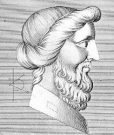 |
ARCHYTASTaranto, 4th century B.C. |
Greek scientist, philosopher and important Pythagorean mathematician from Taranto in Southern Italy (flourished between 400 and 350 BC). He is sometimes described as the founder of mathematical mechanics, but also as perhaps the most important scholar of acoustics in ancient Greece.
He took an active part in political life and was so admired by his fellow citizens for his knowledge, morals and personal virtues that they elected him seven times general (governor) of Taranto, although the law did not allow him to hold this office for longer than one year. Aristotle and Aristoxenos wrote treatises on his life and writings, while Plato, who was his close friend, found in Archytas a supporter when he faced the hostility of Dionysius II of Syracuse. Plato himself used many of his mathematical works and there are indications that Euclid also used many of Archytas' results in Book VIII of the Elements. Finally, tradition places him as the first aeromodeller, since he is said to have built a wooden pigeon,
Archytas, who belonged to the second generation of students of Pythagoras, the Greek philosopher who emphasized the importance of numbers for the interpretation of all phenomena, tried to combine empirical observation with Pythagorean theory. In geometry he solved the cube doubling problem (Delian problem) using half-cylinders in a three-dimensional model. He applied his conclusions about continued fractions, expressed as α:β=β:γ=γ:δ, to musical harmony.
Archytas must have actually participated in the researches of the Pythagoreans around the measurement of distances. He tried to determine their relationships in all three genres of ancient Greek music.
His students not only knew that the relationships of harmonic intervals could be represented numerically, but also related the pitch to the speed of a pulsating movement in the air: the faster the speed, the sharper the note. According to the Byzantine Commentary on Ptolemy's Harmonics, Archytas' teaching on the relationships of the musical notes to each other was based on the observation that the short flute pipe gives a sharper sound, and the long one deeper. According to another version, Archytas's views on the relationship of the intervals in the flute also influenced Nicomachus in his Harmonics.